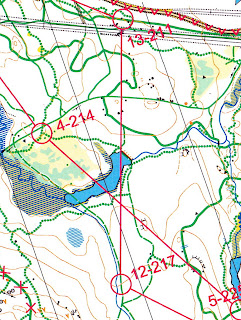For
the past month and for the next two, I am taking part in an
educational exchange to Oviedo, Spain. There is a lot of orienteering in Europe, so before I departed, I got in touch with a coach from
here. He said he was willing to let me tag along to a couple of races
throughout the course of my stay. As orienteering starts early here
(there is no snow), I got my first opportunity this last weekend.
Now,
Oviedo is in the mountains that cap off the top of Spain, but the
competition, which was near Valladolid, was in the typical
flat-as-anything central part of Spain. The terrain was really,
really different from what I was used to. In addition to the lack of contours, the
trees resembled - in my opinion – umbrella trees from Africa.
 |
| A couple of the "umbrella trees" and the open forest |
Because
they are so tall, have very few branches and are so spaced out, I
often had difficulties telling open forest apart from meadow with
multiple distinct trees. I found that the map from the first day
resembled a paint-spattered canvas of yellow, white and different
shades of green. In addition, there were a lot of small, 30 cm high
rock piles that were identified as boulders on the map. This added a
pepper-shaker feel to the map with at least 400 little black
triangles.
The
weekend was divided into two races. The first, on the Saturday, was
a relay event. The team I raced with was comprised of Jimena, a
local Spanish girl running the first leg, myself as the Canadian
running the second, and Nils, a boy from Germany, finishing with the
third. We made quite the international team! I managed to keep my
act together for most of the race, although I lost it at times and
had to bail to trails in order to relocate. I never realized how
much I depend on contours. Without them, my whole orientation
strategy had to change!
 |
| This is the start of the relay. You can see one of the characteristic "boulders" in the bottom right corner. | | | | |
 |
| Where are the contours? |
 |
| Knowing when to leave the trail was the challenging part... |
The
second day was an individual race. Thankfully, there were contours!
I found out that I had been registered in the elite women category,
which did not lower my nervousness level. I also found out that the
contours were 2.5 m contours with many of them being form-lines. My
course was 5.1 km long, and had only 65 m of climb! As I started the
race, I found the 1:10 000 scale to be much faster than I was used
to. The forest was so open that it took very little time to cover a
larger distance.
 |
| The finish shoot. Even for the smaller races, they have a huge blow-up finish gate! |
 |
| They had an ambulance drive all the way to the finish. Thankfully, it was not needed. |
 |
| A couple of people finishing. |
The individual
race went a lot better than the relay. I enjoyed the difference in
terrain, as the course took me through both an open meadow area as
well as a greener area.
 |
| The long straight meadows were actually sand tracks. Not quite the same as a well packed trail. |
The bridge crossing was a path cut through the dark green to allow for passage. A photographer was on hand to catch me land one footed in the creak and clamber up the opposite bank.
I'm
really happy I got the chance to go to this competition, and I hope I
will be able to go to at least one more competition before I return to
Whitehorse.

















